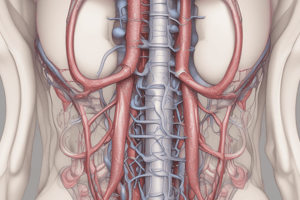Podcast
Questions and Answers
What is the main function of the seminiferous tubules?
What is the main function of the seminiferous tubules?
- To store cholesterol for steroid hormone production
- To support the development of spermatozoa
- To produce testosterone
- To produce sperm (correct)
What type of cells are found in the epithelium of vasa efferentia?
What type of cells are found in the epithelium of vasa efferentia?
- Columnar cells with only absorptive function
- Cuboidal cells
- Squamous cells
- Columnar cells with both absorptive and ciliated functions (correct)
What is the function of the interstitial cells of Leydig?
What is the function of the interstitial cells of Leydig?
- To support the development of spermatozoa
- To produce androgens (correct)
- To store cholesterol for steroid hormone production
- To produce spermatozoa
What is the characteristic of the epithelium of vasa efferentia?
What is the characteristic of the epithelium of vasa efferentia?
What is the function of the Sertoli cells?
What is the function of the Sertoli cells?
What is the structure that surrounds the seminiferous tubules?
What is the structure that surrounds the seminiferous tubules?
What is the main function of the epididymis?
What is the main function of the epididymis?
What is the characteristic of the cytoplasm of Leydig cells?
What is the characteristic of the cytoplasm of Leydig cells?
What is the primary function of the epididymis?
What is the primary function of the epididymis?
What type of epithelium lines the mucosa of the vas deferens?
What type of epithelium lines the mucosa of the vas deferens?
Which component is not found in the spermatic cord?
Which component is not found in the spermatic cord?
Which feature is unique to the ejaculatory duct?
Which feature is unique to the ejaculatory duct?
Which layers of muscle are found in the vas deferens?
Which layers of muscle are found in the vas deferens?
Which structure directly joins the seminal vesicle to form the ejaculatory duct?
Which structure directly joins the seminal vesicle to form the ejaculatory duct?
What type of epithelium is found in the penile urethra?
What type of epithelium is found in the penile urethra?
Which aspect is not associated with the epididymis?
Which aspect is not associated with the epididymis?
Study Notes
Male Genital System
- The male genital system consists of two parts: exocrine (seminiferous tubules producing sperms) and endocrine (interstitial cells of Leydig producing testosterone).
Testis
- The testis has a parenchyma formed by seminiferous tubules and interstitial cells of Leydig.
- Seminiferous tubules produce sperms and are lined by spermatogenic epithelium.
- Interstitial cells of Leydig produce testosterone.
- The seminiferous tubules are lined by spermatogenic epithelium that consists of:
- Spermatogenic cells
- Sertoli cells (supporting cells)
- Leydig cells store cholesterol in lipid droplets for steroid hormone (testosterone) production.
Epididymis
- The epididymis is a long coiled tube (5-6 meters) that stores sperm prior to entry into the ductus deferens.
- It is important for storage and maturation of sperm, and sperm acquire motility and decapacitation factors.
Ductus Deferens (Vas Deferens)
- The ductus deferens carries sperm from the epididymis to the ejaculatory duct.
- It has a mucosa lined with pseudostratified columnar epithelium with stereocilia.
- The musculosa has three layers of smooth muscle, and the adventitia is loose CT.
Spermatic Cord
- The spermatic cord consists of a core of connective tissue containing the vas deference, pampiniform plexus of veins, testicular artery and vein, nerve fibers, and cremasteric muscle (striated involuntary).
Ejaculatory Duct
- The ejaculatory duct is formed by the ampulla of the ductus deferens joining the seminal vesicle.
- It is 1 cm long, lined by simple columnar epithelium, and has no smooth muscle in its wall.
Urethra
- The urethra is a tube that carries urine from the urinary bladder out of the body and also carries sperm out of the body.
- It has glands of Littre throughout its length.
- The lining epithelium varies along the length of the urethra:
- Prostatic urethra: internal sphincter (transitional)
- Membranous urethra: pseudostratified
- External sphincter and penile urethra: stratified columnar then stratified squamous
Studying That Suits You
Use AI to generate personalized quizzes and flashcards to suit your learning preferences.
Description
This quiz covers the anatomy of the male genital system, including the structure and function of seminiferous tubules and interstitial cells of Leydig.


